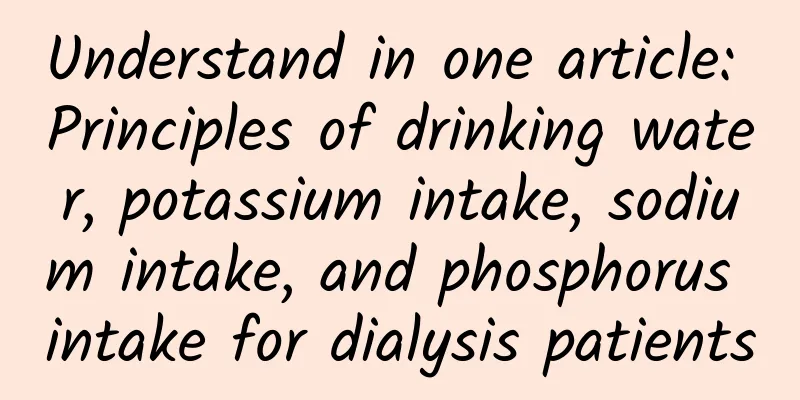Understand in one article: Principles of drinking water, potassium intake, sodium intake, and phosphorus intake for dialysis patients

|
In addition to a low-protein diet, it is also important for dialysis patients to ensure daily energy supply and vitamin supplementation, as well as drinking water, potassium intake, sodium intake, and phosphorus intake. Today, we will show you what dialysis patients need to pay attention to in these aspects. How do hemodialysis patients drink water? When the patient does not have edema or hypertension and the daily urine volume is greater than 1500 ml, there is basically no limit on the amount of water to drink, as long as the weight gain between dialysis sessions does not exceed 5% of the dry body weight. The amount of water that patients on maintenance hemodialysis should drink is the sum of the urine volume of the previous day plus 500 to 800 ml of insensible water loss. In addition, food also contains water, so it cannot be ignored. Tips for controlling water intake: (1) Foods such as porridge, fruits, and canned products contain a lot of water, so do not eat too much. (2) Do not eat food that is too salty. (3) Eat a light diet, cook your own meals, and use less MSG. (4) Patients with low urine output should avoid drinking porridge or soup as much as possible. Tips for controlling water intake: Evenly distribute the amount of water you can drink in a day, put it in a container with a scale or mix some water with lemon juice to make ice cubes, hold them in your mouth when you are thirsty, and let the ice cubes melt slowly. When you are slightly thirsty, you can moisten your lips with a cotton swab or rinse your mouth, and drink water in small sips when you are very thirsty. Principles of potassium-restricted diet for dialysis patients The amount of potassium in the diet depends on the urine volume and blood potassium level. Potassium is excreted when there is urine, and potassium is basically unlimited or slightly limited when the urine volume exceeds 500 ml; the daily potassium supply for anuric hemodialysis patients is less than 2 grams, especially for diabetic nephropathy patients; the daily potassium supply for anuric peritoneal dialysis patients is 3 to 4 grams. The potassium in food is mostly concentrated in the husk, peel and flesh of grains, and potassium is easily soluble in water. Thick vegetable soup, fruit juice and broth all contain a considerable amount of potassium, so the following methods can be used to reduce potassium intake. 0 1 Vegetables After blanching in boiling water, pick up the food and stir-fry or mix with a small amount of oil. Avoid eating vegetable soup and lettuce. 0 2Fruit Avoid eating high-potassium fruits such as kiwi, cantaloupe, strawberry, date, banana, etc. 0 3 Meat Do not eat rice with condensed soup or gravy. 04 Beverages Avoid coffee, tea, sports drinks, etc. 05Seasoning Do not use low-sodium salt, healthy and delicious salt, and salt-free soy sauce that use potassium salt instead of sodium. 06Others Nuts, chocolate, tomato sauce, dried fruits and medicinal soups are high in potassium and should be avoided. Sodium restriction diet for dialysis patients Patients with oliguria or anuria, accompanied by edema, hypertension or congestive heart disease, need to follow a sodium-restricted diet. A sodium-restricted diet should avoid processed foods, such as pickled and cured products, canned foods, etc., and be cautious in using condiments such as soy sauce, black vinegar, monosodium glutamate, chicken essence, chili sauce, and bean paste, and only use low-sodium salt and salt-free soy sauce. Condiments such as sugar, white vinegar, wine, pepper, five-spice, star anise, lemon juice, coriander, onion, ginger, and garlic can be used to increase the palatability of food. However, it is also necessary to avoid excessive sodium restriction to prevent the occurrence of hyponatremia. Phosphorus-restricted diet principles for dialysis patients Patients with chronic renal failure are prone to hyperphosphatemia. The key to treating secondary hyperparathyroidism in chronic renal failure is to control phosphorus metabolism, an important part of which is to actively limit the phosphorus content in the diet. In short, if dialysis patients want to be in better health, they must strictly control their dietary intake while undergoing dialysis. Only in this way can they achieve better treatment effects and improve the quality of life of dialysis patients. |
<<: You can tell whether you have kidney disease by looking at your urine!
>>: Deadly skin infection: Necrotizing fasciitis
Recommend
What is a breast cyst?
Breast cysts are divided into simple cysts and ga...
What are the functions of the pleura?
The pleura is a very smooth serous membrane that ...
Does ovulation bleeding affect pregnancy? The impact of ovulation bleeding on pregnancy
Many women experience this in their daily lives: ...
Treatment of fluid-occupying lesions in the uterine cavity
Many people have never heard of fluid in the uter...
How should postpartum hair loss be treated?
Many of our friends often experience symptoms of ...
Can I still test pregnancy after leaving urine for 3 hours?
Some women are very anxious to get pregnant, so t...
Will Mycoplasma Pneumonia Cause "White Lung"? Expert Interpretation
Five questions and answers about Mycoplasma pneum...
What are the contraindications of Chinese medicine during lactation?
I believe that many mothers who have given birth ...
What to do if you have spotting and stomach pain during pregnancy
Women's immunity decreases during pregnancy, ...
What is the stage of cancer if there is clear water discharge from the nipple?
There are many types of breast diseases among fem...
Do I need to wash the breast stickers after using them for the first time?
The breast stickers you buy need to be cleaned. G...
What foods are good for the uterus and ovaries?
The uterus and ovaries have always played an impo...
What to do in the early stages of an unexpected pregnancy
Some women are not ready to have children, so une...
What are the reactions during the 15th week of pregnancy?
Pregnant women have different physical and psycho...
Is it easy to get HPV when taking a hot spring bath? Doctors explain
In the dead of winter, hot springs and bathing ha...









